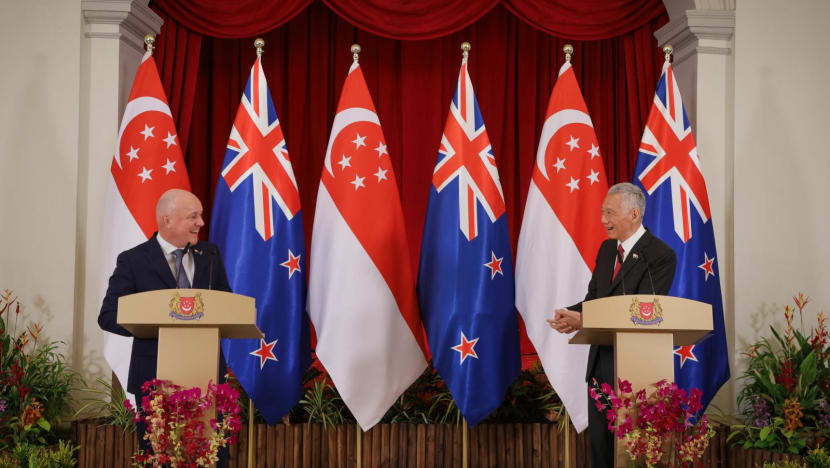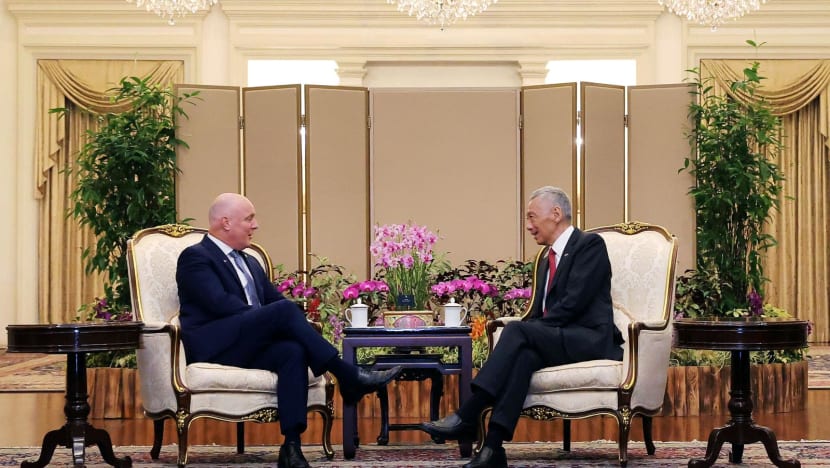Singapore, New Zealand to work together to secure supply chains under new partnership pillar
The new “Supply Chains and Connectivity” pillar will be added to the pre-existing five under the Enhanced Partnership (EP) between both sides.

New Zealand Prime Minister Christopher Luxon (left) and Singapore Prime Minister Lee Hsien Loong at the Istana on Apr 15, 2024. (Photo: Ministry of Communications and Information.)

This audio is generated by an AI tool.
SINGAPORE: Singapore and New Zealand will work together to secure supply chains, building upon efforts from the pandemic, the leaders of both countries announced on Monday (Apr 15).
A new “Supply Chains and Connectivity” pillar will be added to the pre-existing five under the Enhanced Partnership (EP) between both sides.
Prime Minister Lee Hsien Loong said the new pillar “reflects our continuing commitment to keep supply chains connected in a volatile global environment”, in a press conference with his New Zealand counterpart Christopher Luxon at the Istana.
Mr Luxon is on an official visit to Singapore until Tuesday, the first stop of his Southeast Asia trip.
On Monday, he called on President Tharman Shanmugaratnam and met with Mr Lee at the Istana. He will also meet with Deputy PM Lawrence Wong later in the day.
BUILDING ON THE PARTNERSHIP
Singapore and New Zealand had formally upgraded bilateral relations to an EP in May 2019.
“We agreed to begin formal negotiations on an Agreement on Trade in Essential Supplies, to facilitate trade in essential items, and minimise disruptions during crises,” said Mr Lee of Monday’s meeting.
He added that both sides signed two memorandums of understanding (MOU) on electronic invoicing and trade facilitation, which will boost trade links and strengthen cooperation under the Digital Economy Partnership Agreement.
“As small states, Singapore and New Zealand share a deep understanding of the importance of maintaining supply chain connectivity, especially in times of crisis,” said Mr Lee.

He said that in the early months of the COVID‐19 pandemic, when borders were shut and supply chains were disrupted, both countries supported each other.
For instance, an air freight partnership was formed, bringing 100 tonnes of food from New Zealand to Singapore, and essential medical supplies in the other direction.
Mr Luxon said during the press conference that both countries share similar outlooks on regional and global issues, and have warm and personal bonds that have endured many decades.
“It is symbolic that Singapore is my first visit into Southeast Asia. Singapore is an indispensable partner for New Zealand,” he said.
“My government is committed to investing the time and the resources necessary to strengthen New Zealand's international connections, and this starts with prioritising our key relationships with Southeast Asia, including with Singapore.”
He added that peace and stability in Southeast Asia is “absolutely integral to New Zealand security, and we have a stake in Singapore's future”.
MAKING GOOD PROGRESS
Mr Lee shared that all 34 initiatives across the pre-existing EP pillars have made good progress.
“We appreciate New Zealand’s longstanding support for the Singapore Armed Forces’ military training in Waiouru, and look forward to the next edition of Exercise Thunder Warrior in 2025,” he said.
Both countries are also pursuing concrete cooperation under the “Climate Change and Green Economy” pillar, which was added in 2022, including in sustainable aviation and low carbon solutions.
“We are also exploring collaboration in Science, Technology and Innovation, including in data science and future foods,” added Mr Lee.
Both leaders also agreed to elevate the EP next year, the 60th anniversary of diplomatic relations between the two countries.
“We will explore future‐oriented initiatives in areas such as sustainable aviation, the green economy and supply chains,” said Mr Lee.
On the regional and geopolitical front, both leaders agreed on the importance of an open and inclusive rules‐based multilateral order, which supports Association of Southeast Asian Nations (ASEAN) Centrality.
Next year also marks 50 years of dialogue relations between the regional bloc and New Zealand.
Mr Lee welcomed efforts by Mr Luxon’s government to deepen New Zealand’s engagement in this region.
“New Zealand can contribute much to ASEAN’s integration in the digital and green economies,” he said.
Noting Mr Lee’s intention to step down this year, Mr Luxon also paid tribute to the Singaporean leader’s commitment to the Singapore-New Zealand relationship over the tenure of his premiership.
“It is absolutely fitting that we recognise the legacy that you leave for Singapore, the region and beyond. You are quite rightly esteemed as a leader of the highest order for the world,” he said.
“I want to say thank you for your friendship and the wise counsel that you've provided to me, and to New Zealand and for other prime ministers over many, many years.”
Earlier in the day, Mr Luxon had received a new orchid hybrid named in his honour — the Dendrobium Christopher Luxon.
Mr Lee also hosted his New Zealand counterpart to an official lunch, where he highlighted both countries’ close people‐to‐people ties, noting that close to 140,000 New Zealanders visited Singapore last year, while over 47,000 travelled in the opposite direction.















